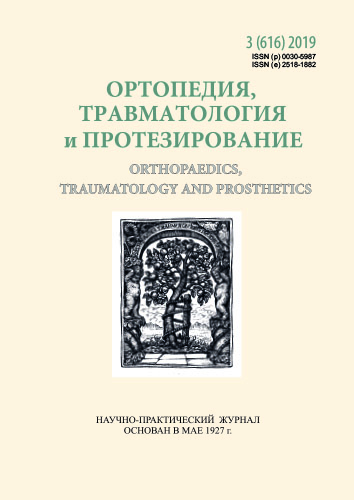The conservative treatment of ligamentogenic lumbopelvic pain
DOI:
https://doi.org/10.15674/0030-59872019343-48Keywords:
lumbopelvic pain, ligamentopathy, «Protecta», shock-wave therapyAbstract
An increased density of ligaments in the lumbopelvic region, that is typical for ligamentopathy, causes redistribution of the stressstrain state of structures in the biomechanical system «lumbar spine – sacrum – sacroiliac joint – pelvis», thereby provoking development of degenerative-dystrophic changes. Proceeding from the above, the concept of conservative treatment for ligamentogenic lumbopelvic pain (LLPP) should provide restoration of the natural density of the ligament and use of structuremodifying medicines.
Objective: to develop a biomechanically and pathogenetically based technology for the conservative treatment of LLPP and assess of the efficacy of its use.
Methods: 45 patients with LLPP were divided into three groups: I — extracorporeal shock-wave therapy, II — dietary supplement «Protecta», III — integrated treatment with dietary supplement «Protecta» in combination with shock-wave therapy. The patients’ condition was assessed before the treatment, after 1 and 3 months following its finishing.
Results: reduction of the pain and functional limitations was registered in patients from all the groups. Nevertheless the pain, stiffness and functional insufficiency decreased most significantly in cases from group III. Following 1 and 3 months after the end of their treatment course, these patients’ blood serum revealed lower values of destruction in their cartilaginous and osseous tissues as well as a reduced activity of marker enzymes. Biochemical marker values after 1 month following the end of their treatment course in patients from groups I and III were better versus group II, but after 3 months the dynamics of the examined indices were more expressed in groups II and III.
Conclusion: the developed technology for conservative treatment of LLPP with use of extracorporeal shock-wave therapy and dietary supplement «Protecta» is effective, as it is confirmed by results of clinical and biochemical studies.
References
- Panjabi, M. M. (2006). A hypothesis of chronic back pain: ligament subfailure injuries lead to muscle control dysfunction. European Spine Journal, 15 (5), 668–676. doi:10.1007/s00586-005-0925-3
- Ammer, K. (2010). Schmerzhaftes Iliolumbalband: physiologische Grundlagen. Manuelle Medizin, 48 (2), 141–144. doi:10.1007/s00337-010-0752-4
- Yurkovsky, A. M., Anikeev, O. I., & Achinovich, S. L. (2011). Comparison of sonographic and histological data with dystrophic changes in the lumbariliac sacrista. Journal of the Grodno State Medical Institute, 4, 74–77. (in Russian)
- Istomin D. A., Banit, O. V., & Istomin, A. H. (2018). Mathematical modeling of changes in ‘lumbosacral region of the spine-pelvis’ kinematic chain in iliolumbar ligament syndrome. The New Armenian Medical Journal, 12 (3), 58–66.
- Dagenais, S., Haldeman, S., & Wooley, J. R. (2005). Intraligamentous injection of sclerosing solutions (prolotherapy) for spinal pain: a critical review of the literature. The Spine Journal, 5 (3), 310–328. doi:10.1016/j.spinee.2004.09.011
- Airaksinen, O., Brox, J. I., Cedraschi, C., Hildebrandt, J., Klaber-Moffett, J., & Kovacs, F. (2006). Chapter 4 European guidelines for the management of chronic nonspecific low back pain. European Spine Journal, 15(S2), s192-s300. doi:10.1007/s00586-006-1072-1
- Levenets, M. V. & Regan, M. M. (2012). Shock wave therapy in orthopedics and operative medicine. Kyiv: Phoenix. (in Ukrainian)
- McGettigan, P., & Henry, D. (2006). Cardiovascular risk and inhibition of cyclooxygenase. JAMA, 296 (13), 1633. doi:10.1001/jama.296.13.jrv60011
- Kamyshnikov V. S. (2003). Clinical and biochemical laboratory diagnostics. Handbook in 2 volumes. Minsk: Interservice. (in Russian)
- Morozenko, D. V., & Leontyeva, F. S. (2016). Methods of research of connective tissue metabolism markers in modern clinical and experimental medicine. Young scientist: scientific journal, 2 (29), 168–172. (in Ukrainian)
Downloads
How to Cite
Issue
Section
License
Copyright (c) 2019 Andrii Istomin, Аlina Kalyuzhka, Dmytro Istomin, Viktor Kyryllov, Iuliia Zhuravska, Kseniia Dorohan

This work is licensed under a Creative Commons Attribution 4.0 International License.
The authors retain the right of authorship of their manuscript and pass the journal the right of the first publication of this article, which automatically become available from the date of publication under the terms of Creative Commons Attribution License, which allows others to freely distribute the published manuscript with mandatory linking to authors of the original research and the first publication of this one in this journal.
Authors have the right to enter into a separate supplemental agreement on the additional non-exclusive distribution of manuscript in the form in which it was published by the journal (i.e. to put work in electronic storage of an institution or publish as a part of the book) while maintaining the reference to the first publication of the manuscript in this journal.
The editorial policy of the journal allows authors and encourages manuscript accommodation online (i.e. in storage of an institution or on the personal websites) as before submission of the manuscript to the editorial office, and during its editorial processing because it contributes to productive scientific discussion and positively affects the efficiency and dynamics of the published manuscript citation (see The Effect of Open Access).














